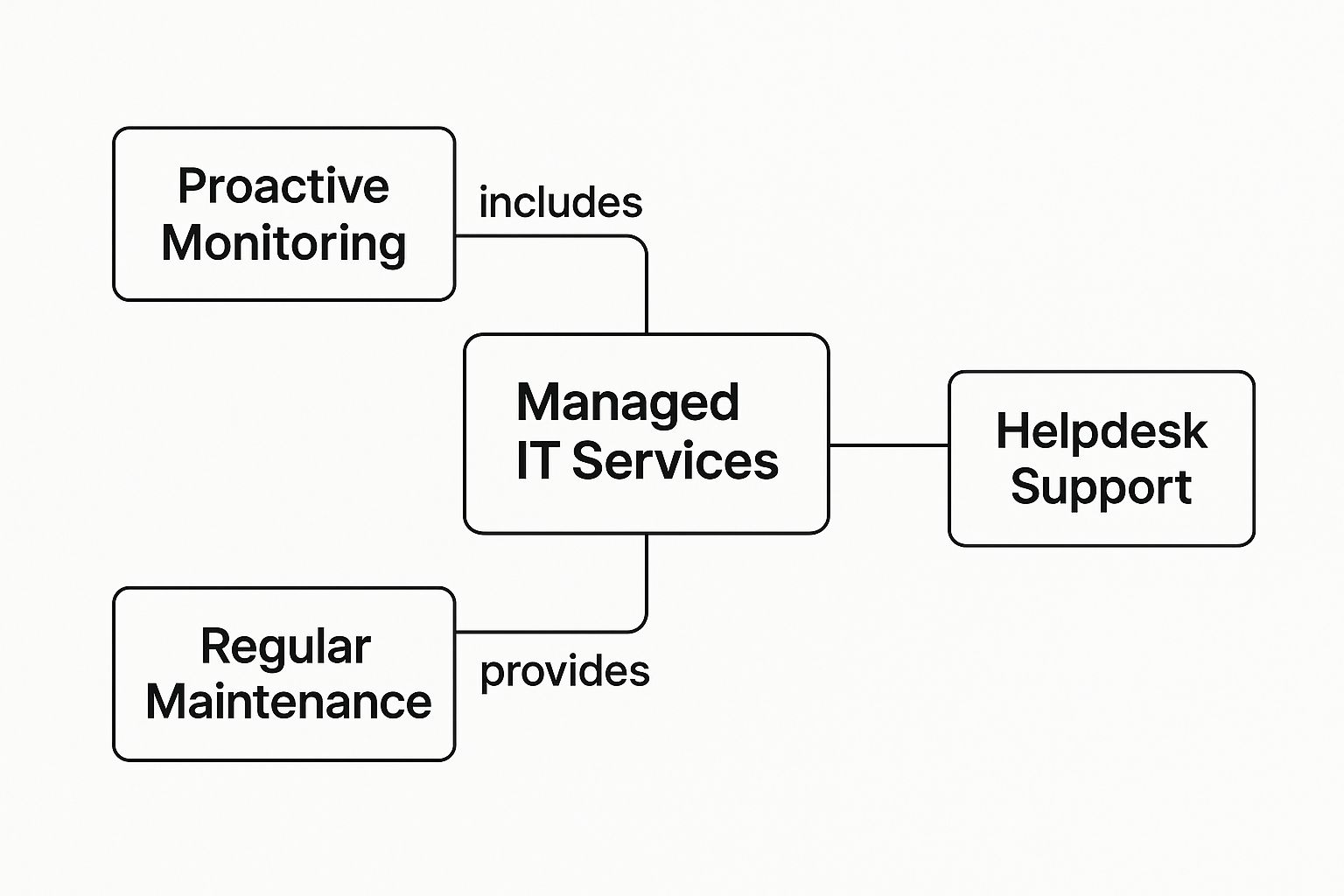Think of managed IT services as handing over the keys to your entire technology infrastructure to a dedicated team of experts. Instead of just calling someone when things break, you're partnering with a third-party company, known as a Managed Service Provider (MSP), who takes complete ownership of your IT. For a single, predictable monthly fee, they look after everything from maintenance and security to day-to-day support.
So, What Are Managed IT Services in Practice?
Let’s use an analogy. Imagine your business is a high-performance car. The old-school approach to IT, often called 'break-fix', is like waiting for a warning light to flash on the dashboard before heading to the garage. You only pay when something goes wrong, but by then, you’re already dealing with downtime and unexpected costs.
Managed IT services flip that model on its head. It’s like having your own dedicated pit crew working around the clock. They’re constantly monitoring every part of the engine, fine-tuning performance, and spotting potential issues long before they can cause a breakdown. Their job is to keep you on the track, running at peak performance, without any interruptions.
This proactive approach means your MSP is working behind the scenes to prevent problems from ever happening. A server crashing, a user getting locked out, or a security breach—their goal is to stop these things in their tracks so you can focus on what you do best: running your business.

As you can see, the service is built on three key pillars: continuous monitoring, preventative maintenance, and rapid-response support. It's a complete system designed for stability.
The Shift from 'Nice-to-Have' to 'Need-to-Have'
This proactive model isn't just a luxury anymore; it's becoming a business necessity. The numbers tell the story: the UK's managed IT services market was valued at a staggering £15.35 billion in 2023 and is expected to soar to £28.29 billion by 2032. This incredible growth shows just how vital reliable, secure, and efficient technology has become for businesses of all sizes.
A Managed Service Provider’s success is directly tied to your stability. Their incentive is to keep your systems running flawlessly, which aligns their goals perfectly with yours—a true strategic partnership.
By outsourcing the daily technical headaches, you gain access to a deep bench of expertise without the hefty price tag of hiring a full-time, in-house team. It gives you not just peace of mind, but also a clear, predictable budget for all your technology needs. You can learn more about how our approach to managed IT support can directly benefit your business.
Traditional IT Support vs Managed IT Services
The difference between the old 'break-fix' model and modern managed services is night and day. One is reactive and unpredictable, while the other is proactive and strategic.
| Aspect | Traditional IT Support (Break-Fix) | Managed IT Services |
|---|---|---|
| Approach | Reactive – waits for problems to occur. | Proactive – actively prevents issues. |
| Goal | Fix technology when it breaks. | Ensure technology runs smoothly and securely. |
| Cost Model | Unpredictable, hourly rates or per-incident fees. | Predictable, fixed monthly subscription. |
| Relationship | Transactional – service is provided as needed. | Partnership – aligned goals for long-term stability. |
| Downtime | Frequent and unexpected. You only call when you're down. | Minimal and planned. Focus is on maximising uptime. |
| Focus | Solving immediate, isolated technical problems. | Strategic management of the entire IT environment. |
Ultimately, the choice comes down to whether you want an IT provider who profits from your problems or one who profits from your success. Managed services ensure your technology becomes a reliable asset that drives your business forward, not a source of constant frustration.
What’s Actually in a Managed IT Services Plan?

When you team up with a Managed Service Provider (MSP), you’re getting much more than just a helpline for when your computer acts up. A good plan is a complete system designed to keep your business secure, efficient, and operating smoothly. It’s less like a single tool and more like an entire pit crew working in the background so you can stay focused on winning the race.
Let's break down the essential pieces that really make up a solid managed IT services agreement.
Proactive Monitoring and Maintenance
This is the preventative medicine for your entire IT setup. Instead of just reacting when a server crashes or the network goes down, an MSP uses specialised software to keep an eye on everything 24 hours a day, 7 days a week.
This constant watchfulness means they can spot early warning signs—a hard drive getting dangerously full or some strange network activity—and fix them before they grow into full-blown disasters. Think of it as fixing a small leak in a pipe before it bursts and floods the entire office. A huge part of this is routine maintenance, like applying security patches and software updates, which keeps everything running at its best.
Robust Cybersecurity Defences
Let’s be honest, cybersecurity isn't a 'nice-to-have' anymore; it's absolutely essential for survival. An MSP brings a multi-layered security approach that most small businesses would find incredibly expensive and complicated to build on their own.
This isn’t just one piece of software, but several elements working together:
- Advanced Threat Protection: This goes way beyond standard antivirus, using sophisticated tools to catch the nasty stuff.
- Firewall Management: Your firewall is your network’s front door, and an MSP makes sure it’s properly configured, locked, and monitored.
- Email Security: Filtering out phishing scams, spam, and dangerous attachments before they ever land in your team's inboxes.
- Security Audits: Performing regular check-ups to find and fix weak spots in your defences.
A proper managed services plan doesn't just wait for an attack—it's actively looking for potential threats. The aim is to build a resilient shield that protects your data, your reputation, and your bottom line from the constant barrage of cyber risks.
Data Backup and Disaster Recovery
Ask yourself this: what would you do if all your business data disappeared tomorrow? It could be a hardware failure, a ransomware attack, or even a simple accident. For many, the result would be catastrophic. This is where backup and disaster recovery (BDR) becomes a lifesaver.
Your MSP sets up automatic, frequent backups of your critical data, often storing copies both on-site for speed and in the cloud for safety. But the backup is only half the story. The "recovery" part is a clear, tested plan to get your systems and data back online fast, ensuring your business can carry on. It turns a potential company-ending event into a manageable hiccup.
It’s also important to understand how these services are bundled and billed. Take some time to explore the different Managed Service Provider pricing models to see what fits your budget and needs, as providers often package these core services in various ways.
The Real-World Benefits for Your Business

It’s one thing to know what’s in a managed IT services plan, but it’s another thing entirely to see how those services actually make a difference to your bottom line. We're not just talking about fixing computers; we're talking about a genuine partnership that fuels your company's growth, security, and day-to-day efficiency.
The most immediate change you’ll notice is how you handle your IT budget. Forget the chaos of the old break-fix model, where every glitch meant another surprise invoice. A managed service moves you to a stable, fixed monthly cost, making financial planning predictable and, more often than not, reducing your total technology spend over time.
That kind of financial stability means you can plan for the future with confidence, knowing your essential IT expenses are already covered.
Gaining a Strategic Advantage
Beyond predictable costs, working with a Managed Service Provider (MSP) is like instantly hiring an entire team of specialists. For most small and medium-sized businesses, having a full-time cybersecurity expert, a cloud architect, and a network engineer on the payroll just isn't realistic.
An MSP gives you all that collective knowledge on demand. Suddenly, your business has access to top-tier technology and strategies that were previously out of reach, helping you compete on a more even footing with larger companies. This access to high-level skills is a key reason so many businesses are exploring the full range of managed IT services benefits.
Focus on What Truly Matters
Perhaps the most powerful benefit is the freedom it gives back to your team. When you aren't constantly pulled away to deal with IT headaches—from forgotten passwords to server updates—you can channel all that energy back into your core business.
By outsourcing the day-to-day technological firefighting, your staff can focus on innovation, improving customer service, and driving revenue. This strategic shift turns your team from reactive problem-solvers into proactive business-builders.
This ability to focus has never been more critical. The growing need for solid cybersecurity and smooth digital operations are huge drivers for managed services adoption. The global market is expected to reach a staggering USD 572.15 billion by 2033, with UK businesses increasingly turning to experts to protect sensitive data and navigate complex regulations. You can find more on this explosive growth in a market report by Renub Research.
Ultimately, managed IT services do more than just look after your tech. They create an environment where your business can finally flourish, free from technical obstacles.
Finding the Right Managed Services Model

Managed IT isn't a one-size-fits-all solution; it's a flexible partnership. Just like you wouldn't use the same tool for every job, Managed Service Providers (MSPs) offer different ways of working to match your specific business needs. Picking the right one is the first, and most important, step to building a great relationship.
When you understand the different structures, you can find a partner whose services genuinely align with your budget, goals, and the team you already have. It's the best way to avoid paying for support you don’t need or, even worse, discovering a critical gap in your coverage when you can least afford it.
The All-You-Can-Eat Model
Think of this as the all-inclusive option. The all-you-can-eat model is incredibly popular because it's simple and comprehensive. For one flat monthly fee, it covers pretty much all your IT needs—from 24/7 monitoring and helpdesk support to cybersecurity and long-term planning. No surprise bills, no hidden fees.
This approach is perfect for businesses that need predictable costs and complete peace of mind. The incentive is perfectly aligned: your MSP is motivated to keep your systems running smoothly because every problem they have to fix costs them time and money, not you. It’s a truly proactive partnership.
Tiered and A La Carte Models
A tiered model is another common setup. Here, providers package their services into different levels—think Bronze, Silver, and Gold. Each tier adds more features and a higher level of support, letting you choose a plan that fits your current needs and budget while leaving room to grow.
The a la carte model offers the ultimate flexibility. Just need help with one thing? This approach lets you hand-pick individual services, such as:
- Cybersecurity Management: Focused protection against online threats.
- Cloud Services: Expert help with managing your cloud infrastructure.
- Data Backup and Recovery: A dedicated service to safeguard your most important information.
It’s an ideal choice for companies that already have some IT staff but need to plug a specific skills gap.
Co-Managed IT
But what if you already have an IT team? The co-managed IT model was designed for this exact situation. It’s not about replacing your internal staff but about making them even better. The MSP works side-by-side with your team, bringing specialist skills and handling the day-to-day grind.
With co-managed IT, the MSP might handle routine network monitoring and software updates. This frees up your in-house experts to focus on the big-picture projects that actually drive the business forward. It's a true collaboration that gives you the best of both worlds.
This model strengthens your IT department without the hefty price tag of hiring more full-time staff. By exploring the different forms of outsourced IT support, you can find a partnership that truly enhances your team’s capabilities.
To make things clearer, let's break down how these different models stack up against each other.
Overview of Managed Service Provider (MSP) Models
| Service Model | Best For | Pricing Structure | Key Feature |
|---|---|---|---|
| All-You-Can-Eat | Businesses wanting predictable costs and full IT coverage. | Fixed monthly fee. | Comprehensive, proactive support for a flat rate. |
| Tiered | Companies that want to balance features with budget and scale later. | Fixed monthly fee based on the chosen tier. | Pre-packaged service levels (e.g., Bronze, Silver, Gold). |
| A La Carte | Organisations with in-house IT that need specific support. | Per-service or per-device pricing. | Maximum flexibility to pick and choose individual services. |
| Co-Managed | Businesses with an existing IT team that needs extra support. | Customised fixed fee or project-based. | A collaborative partnership between your team and the MSP. |
Ultimately, the right model depends entirely on your business. By understanding these options, you're in a much better position to choose an IT partner who can help you achieve your goals.
Knowing When It’s Time to Make the Switch
So, how do you know when your current IT setup just isn't cutting it anymore? Spotting the warning signs is the first step. For many businesses, the problems creep up slowly—a minor frustration here, a small glitch there—until they snowball into major headaches that kill productivity and hold back growth.
It usually starts small. Maybe your team is constantly getting bogged down by the same old technical issues, day in and day out. What seems like a minor annoyance at first quickly becomes a serious drain on everyone's time, pulling your best people away from their core work to play amateur IT support. This is the classic break-fix cycle in action.
When your team is spending more time putting out fires than moving the business forward, that’s your cue. It’s a clear signal that you need a partner who can get ahead of these problems before they even start.
Key Triggers for Change
If any of the following scenarios sound familiar, it’s a strong sign that your business is ready for managed IT services. These aren't just isolated incidents; they're symptoms of a bigger problem that needs a more strategic approach.
-
Unpredictable and Rising Costs: Are you constantly being blindsided by hefty IT bills for emergency fixes? If your tech budget feels like a rollercoaster and you’re not sure what you're getting for your money, the stability of a fixed-fee model will be a breath of fresh air.
-
Growing Cybersecurity Worries: As your business expands, so does your appeal to cybercriminals. That nagging feeling that your defences against phishing, ransomware, and data breaches might not be up to scratch is a serious red flag.
-
Lack of a Clear Tech Roadmap: Does your business actually have a plan for its technology? Without one, you’re just reacting. You end up making expensive, short-sighted tech decisions that won’t support where you want to be in two, five, or ten years.
The moment you realise your IT is a source of constant friction rather than a tool for growth, it's time to consider a switch. A true IT partner should be enabling your success, not holding it back.
This isn't just a hunch; it's a trend happening all over the country. The UK's IT services market, which includes managed services, is already massive, generating around USD 105.14 billion in 2024. Projections show it rocketing to nearly USD 180.65 billion by 2032, fuelled by big investments in cloud technology and AI. You can find more insights on what this growth means for UK businesses from Verified Market Research.
At the end of the day, if your technology feels more like a liability than an asset, the writing is on the wall. Bringing in a Managed Service Provider (MSP) is no longer a luxury reserved for giant corporations; it's a fundamental step for any business that's serious about security, stability, and growth.
Here’s the rewritten section, designed to sound completely human-written and natural.
How We Build Your IT Partnership at Ibertech Solutions
Here at Ibertech Solutions, we don’t just see you as another client on a list. We believe that true managed IT is a partnership, a relationship built from the ground up by getting to know your business inside and out. It’s about moving past the generic, off-the-shelf plans to create something that genuinely works for you in Norfolk and Suffolk.
That process always starts with a simple conversation. We sit down and listen.
We want to understand your daily operational headaches, the specific pressures of your industry, and where you want to take your business in the next few years. Are you trying to get more out of your team on the factory floor? Are you wrestling with complex compliance rules? Your answers are what guide everything we do next.
Crafting an IT Strategy That Actually Fits
Forget one-size-fits-all solutions. Our entire approach is about designing a strategy that maps directly to your objectives. This isn't just about fixing what's broken; it's about building a practical, forward-looking plan that turns your technology from a frustrating cost into a genuine driver of growth.
For small and medium-sized businesses, we find our expertise really shines in a few key areas:
- Rock-Solid Cybersecurity: We build defences that make sense for your business, especially if you're in an industry where compliance is non-negotiable. Protecting your data and your reputation is our top priority.
- A Clear Tech Roadmap: We’ll help you develop a clear, sensible plan for your technology’s future, making sure every pound you invest in IT is working towards your long-term success.
- Keeping Your Team Productive: We manage your systems proactively to stamp out downtime before it happens, letting your team stay focused on what they do best.
With Ibertech Solutions, you're not just hiring an IT supplier. You're gaining a strategic partner who is genuinely invested in seeing you succeed. Our mission is to make sure your technology is actively helping you hit your business goals.
This collaborative way of working means every single part of your managed IT service is geared towards giving you an edge. We’ll handle all the technical heavy lifting behind the scenes—from daily monitoring to future planning—so you can get back to running and growing your business with total peace of mind.
Common Questions About Managed IT Services
Even after getting your head around the concept of managed IT, it's completely normal to have a few lingering questions. Most business owners I speak with are curious about the cost, how it works with their existing staff, and what a service provider actually does to improve security. Let's get into it.
The first question is nearly always about price. "What's the typical cost for managed IT services in the UK?" While the final number will depend on the size of your business and how complex your needs are, the conversation is really about value, not just the monthly fee. Think of it as swapping unpredictable, often massive, repair bills for a flat, predictable cost.
This approach nearly always leads to a lower total cost of ownership than the old "break-fix" model. With that reactive method, you're not just paying for a call-out; you're paying in lost productivity and downtime. With managed services, you're paying for stability and prevention, not just disaster recovery.
Can We Keep Our In-house IT Team?
Absolutely. In fact, bringing an MSP on board often makes your in-house team more powerful and effective. This arrangement is called co-managed IT, and it’s a partnership designed for collaboration, not replacement.
In a co-managed setup, we take on the relentless day-to-day grind—things like system monitoring, applying security patches, and handling helpdesk tickets. This frees your internal experts from constant firefighting. Suddenly, they have the time and headspace to focus on the big-picture projects that move your business forward. It really is the best of both worlds.
A co-managed partnership gives your internal experts the back-up and tools they need to shine, transforming your IT department from a cost centre into a genuine engine for innovation.
How Does an MSP Genuinely Improve Cybersecurity?
A professional MSP brings a multi-layered security strategy to the table that's simply out of reach for most small businesses to build and maintain on their own. It's a world away from just installing some antivirus software and crossing your fingers.
Our approach is built on several key pillars:
- Proactive Threat Hunting: We don’t just wait for an alarm to go off. We’re actively looking for vulnerabilities and early signs of trouble.
- 24/7 Network Monitoring: Our systems keep a constant watch over your network, ready to act on suspicious activity the moment it happens.
- Disciplined Patch Management: We make sure every piece of software you use is kept up-to-date, closing the security gaps that criminals love to exploit.
- Employee Security Training: We help turn your team into your first line of defence, teaching them how to spot and avoid common threats like phishing scams.
This creates a tough, comprehensive defence designed to protect your data, your reputation, and your ability to operate smoothly in the face of modern threats.
Ready to see how a proactive IT partnership could benefit your business in Norfolk and Suffolk? Contact Ibertech Solutions Limited today to discuss a strategy that fits your unique goals. Find out more at https://www.ibertechsolutions.co.uk.





